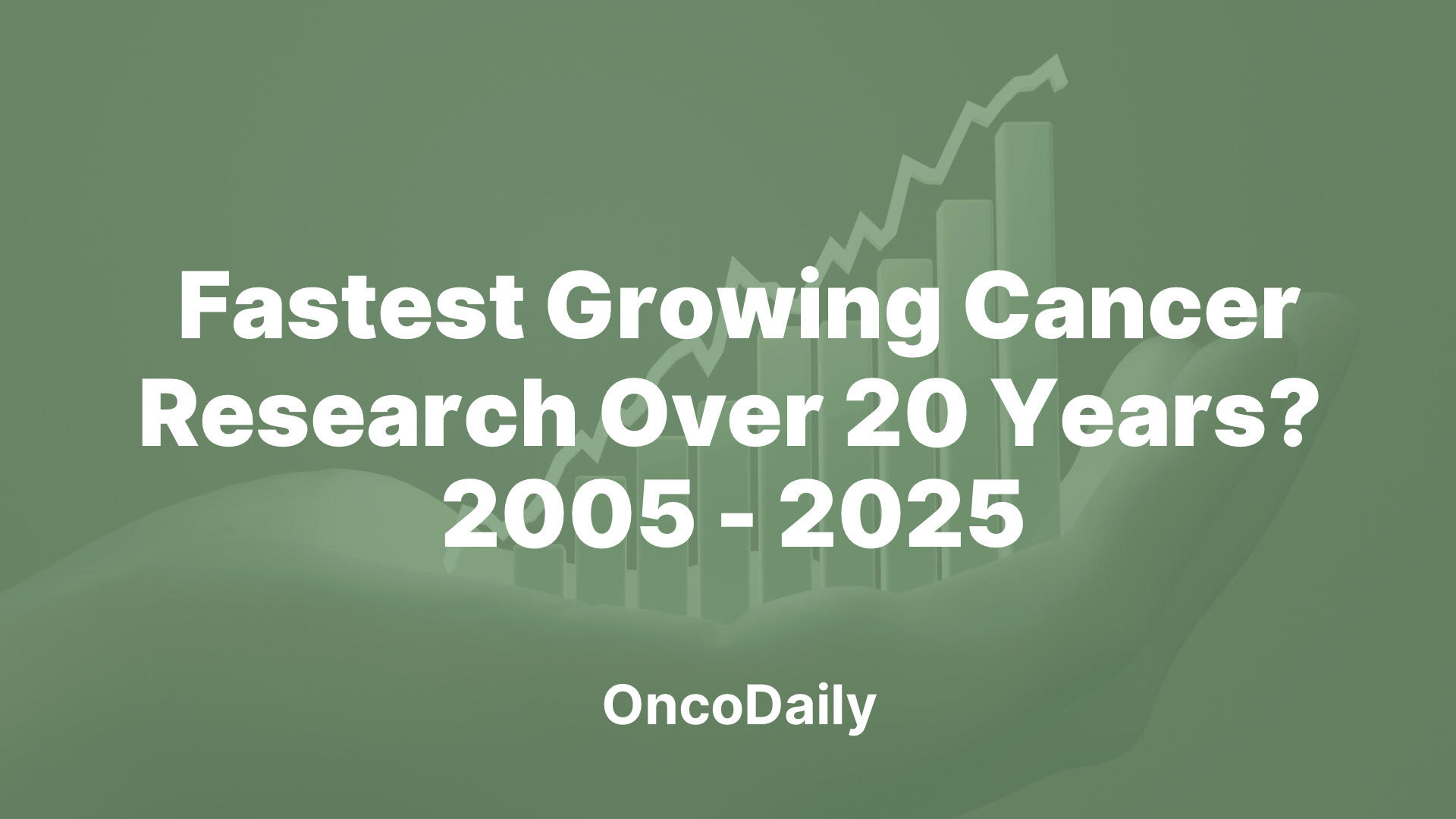Cancer research has expanded rapidly in the 21st century, but this growth has followed a strikingly uneven path across different tumor types. While some cancers have seen a sharp acceleration in scientific activity—including high volumes of original studies, clinical trials, and biomarker investigations—others remain comparatively research-limited, with fewer studies and clinical trials despite a substantial disease burden.
To better understand these disparities, we examined cancer research trends 2005–2025 using bibliometric data from PubMed. The analysis ranks cancer types by the rate of growth in scientific output, revealing which malignancies have drawn the most research attention over the past two decades. Breast, lung, colorectal, prostate, and pancreatic cancers rank among the fastest-rising fields, maintaining strong momentum due to therapeutic breakthroughs, growth in clinical trials, and progress in molecular characterization.

Photo:Depositphotos
For example, immunotherapy, particularly checkpoint inhibitors and cell-based approaches, has played an important role in accelerating scientific output; it represents just one aspect of a broader shift. The overall rise in publications reflects deeper biological understanding, improvements in imaging and genomics, and targeted funding efforts toward cancers with significant unmet clinical needs [1].
Understanding which cancer types have gained prominence in the scientific literature is crucial not only for monitoring scientific progress but also for informing public health strategies and allocating research funding.
Why Do Some Cancer Types Dominate Research Headlines While Others Lag?
Some cancers are “prioritized in headlines”. These types dominate headlines and research trends over others with similar mortality rates due to several intertwined factors, including public awareness and advocacy, government and institutional funding decisions, the responsiveness of certain cancers to new therapies such as immunotherapy, and recent scientific breakthroughs, such as the development of KRAS inhibitors and the use of AI-guided biomarker discovery. Among these, public awareness and advocacy play a foundational role, as cancers with strong advocacy groups—such as breast cancer—tend to attract greater public attention, funding, and media coverage. Awareness campaigns and societal recognition can elevate the research priority of lesser-known cancers, even if their mortality rates are similar.
For instance, breast cancer receives significantly more research funding and attention compared to ovarian cancer, even though ovarian cancer is more lethal and results in more years of life lost per diagnosis. Across studies, funding-to-lethality ratios and clinical trial counts were consistently higher for breast cancer. The only reported 5-year survival rates showed breast cancer at 89 percent and ovarian cancer at 43.7 percent. Survey data confirmed that public awareness of breast cancer is much higher, and media coverage strongly favors it due to widespread campaigns. These findings demonstrate that advocacy and public visibility play a major role in shaping research priorities, often outweighing actual disease burden [2].
Another key intertwined factor is the allocation of funding and healthcare resources, with governments and medical institutions usually prioritizing certain cancers over others, further amplifying disparities influenced by public awareness and advocacy. For example, a 2025 analysis of NIH and other federal funding across 13 cancer types (2013–2022) found that while funding correlated strongly with incidence (Pearson correlation coefficient 0.85), it showed weak correlation with mortality (0.36). This means many highly fatal cancers receive relatively less funding. For example, breast, lung, and prostate cancers received the highest combined funding ($8.36B, $3.83B, and $3.61B, respectively).
In contrast, uterine, cervical, and hepatobiliary cancers were among the least funded despite their clinical impact [3]. Underfunding correlates with fewer clinical trials and slower progress. A 2024 study examining funding from the US NCI and nonprofit organizations (2015–2018) demonstrated that cancers with less funding tended to have fewer clinical trials, thereby limiting research advances. The correlation between funding and trial numbers was very strong (Pearson CC 0.91) [4].
In addition to advocacy and funding priorities, another intertwined factor is the responsiveness of certain cancers to recent scientific and therapeutic breakthroughs. Cancers that respond well to advances such as immunotherapy and targeted therapies tend to draw greater research enthusiasm, which translates into increased publication output, media coverage, and elevated research priority. This trend is particularly evident for breast, lung, and pancreatic cancers, where advances have not only improved patient outcomes but also sparked robust clinical trial activity and expanded scientific inquiry.
For example, breast cancer research has been propelled by the development of novel targeted combination therapies, such as the promising INAVO120 regimen combining a PI3K inhibitor (Inavolisib), a CDK4/6 inhibitor (Palbociclib), and hormone therapy. This approach has shown substantial improvements in progression-free survival and delayed chemotherapy needs in PIK3CA-mutated advanced breast cancer patients, highlighting how targeted treatments stimulate ongoing research and clinical interest. Similarly, lung cancer research is progressing quickly because of new treatments like second-generation KRAS inhibitors and broader use of immunotherapy. These advances reflect efforts to target previously untreatable mutations and to use AI to discover biomarkers in the tumor microenvironment [5].
In parallel, pancreatic cancer, historically difficult to treat and underfunded, is now gaining substantial research momentum due to breakthroughs targeting KRAS mutations, which are present in over 90 percent of patients. New inhibitors such as Sotorasib and Adagrasib, along with investigational agents and cancer vaccines, are showing promising results in clinical trials and driving a surge in scientific publications. In addition, innovative theranostic strategies that combine molecular imaging with targeted radionuclide therapy are being explored not only for pancreatic cancer but also for breast and lung cancers, reflecting a broader wave of precision oncology technologies entering clinical practice [6].
Across these cancers, the interplay of therapeutic success, rising clinical trial activity, and technological innovations drives sustained research surges. The excitement generated by tangible improvements in patient outcomes encourages further funding, investigator interest, and public awareness, creating a reinforcing cycle of prioritization in research agendas and headlines.
Methods: How Were Cancer Research Publication Trends Identified?
To explore emerging directions in cancer research, previous studies have widely used bibliometric and network analysis, increasingly integrating text mining and machine learning for deeper insights. Hybrid methods combining bibliometrics, machine learning, and natural language processing (NLP)—a technique that analyzes large volumes of scientific text to detect patterns and topic trends— proved effective for capturing both broad and detailed shifts. Notably, international collaboration and multi-source data use were seen as crucial for reliable trend analysis.
As a small complementary effort for this article, a manual PubMed search was conducted to provide a simple yet clear visualization of publication trends and research volume. While limited in scope, this exercise aimed to highlight the relative research attention given to each specific cancer type [7,8].
To do this, systematic searches in one authoritative bibliographic database were conducted: PubMed. This database was selected for its extensive indexing of biomedical and clinical literature worldwide. The searches were restricted to original research articles and clinical studies, explicitly excluding editorials, letters, and conference abstracts, to focus on primary scientific contributions. Boolean search strategies were applied to retrieve approximate publication counts for selected cancers. For example: (“breast cancer” OR “breast carcinoma” OR “mammary carcinoma”) AND (“2005″[Date – Publication]: “2025”[Date – Publication]).
The publication date range was confined between January 1, 2005, and December 31, 2025 (with projections for the latest years), allowing for longitudinal trend analysis. All searches were limited to articles published in English to maintain consistency.
Bibliographic metadata, including publication year, document type, and cancer type, were systematically extracted from the databases. Annual publication counts were performed for each cancer type and stratified by publication categories, including clinical trials, meta-analyses, and original research articles.
To evaluate both the volume and the velocity of growth, two primary metrics were employed: (1) absolute publication counts per year and (2) relative growth rates over the study period. These metrics enabled the identification of the fastest-growing areas within cancer research.
The absolute number of general cancer-related publications in PubMed has more than doubled over these 20 years. In 2005, about 6% of all PubMed entries were cancer-related. This proportion has steadily increased over the years, reaching approximately 16% of total PubMed entries by around 2016 and continuing upward thereafter. The total number of cancer-related entries in PubMed has exceeded 3 million overall. Major increases in cancer publication volume reflect advances in molecular biology, genetics, computational methods, and an escalating global focus on cancer research.

Photo: Depositphotos
Organ-specific cancer publications have also increased, with breast cancer publications roughly doubling their share from approximately 4.5% of cancer publications to nearly 11% (relative to total cancer-related PubMed entries) between 1950 and around 2016. Similar upward trends are observed for liver and prostate cancers, while some cancer types, like uterine cancer, have decreased in publication share.
In 2005, there were roughly 15,000 to 20,000 cancer-related publications in PubMed. The annual number of cancer publications steadily increased by about 3% to 5% per year on average over this period. By 2025, the number of cancer-related publications is estimated to exceed 40,000 annually. This represents a more than doubling of yearly publication output in 20 years, consistent with increasing global research investments and cancer incidence. The proportion of cancer-related articles among all PubMed entries rose from around 11% in 2005 to about 16-18% by 2025. The top five cancer types—breast, lung, colorectal, prostate, and pancreatic—have all contributed substantially to this growth.
Breast cancer leads in publication volume throughout the period, followed by lung and colorectal cancers. Pancreatic cancer publications show the most rapid relative increase due to the urgent need for better therapies despite its lower absolute incidence. Growth rates correspond roughly with known epidemiological trends and research interest surges, with breast cancer publications increasing by about 130% from 2005 to 2025, lung cancer growing about 80%, colorectal cancer about 80%, prostate cancer about 75%, and pancreatic cancer about 180% during the same period.
The manual analysis employed a bibliometric approach to examine publication trends in cancer research over the twenty years from 2005 to 2025. To comprehensively capture relevant scientific output, a set of precise keyword-based search queries for each major cancer type was developed, including breast, lung, colorectal, prostate, and pancreatic cancers. Synonyms and related terms were incorporated using Boolean operators (e.g., OR to include variations, AND to define the publication date range) to ensure broad and accurate coverage.
To analyze publication trends related to breast cancer, the following keywords were used in the PubMed search: “breast cancer”, “breast carcinoma”, and “mammary carcinoma”. These terms were combined using the OR operator to ensure comprehensive retrieval of relevant articles. The resulting data reflects the annual publication volume from 2005 to 2025 and is visualized in Figure 1.
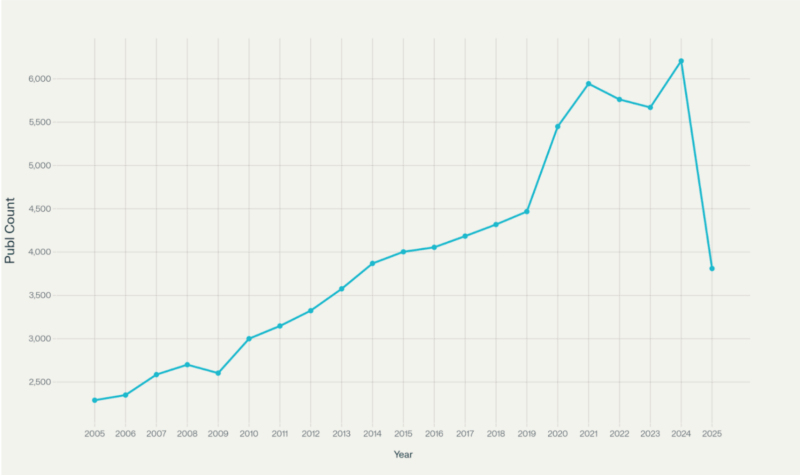 Figure 1.
Figure 1.
For lung cancer, the search strategy included multiple terms to capture the full scope of related literature. The keywords used were “lung cancer”, “non-small cell lung cancer” OR “NSCLC”, “small cell lung cancer” OR “SCLC”, and “pulmonary carcinoma”. These were combined using the OR operator to maximize coverage of both general and specific subtypes. The resulting publication data from 2005 to 2025 are illustrated in Figure 2.
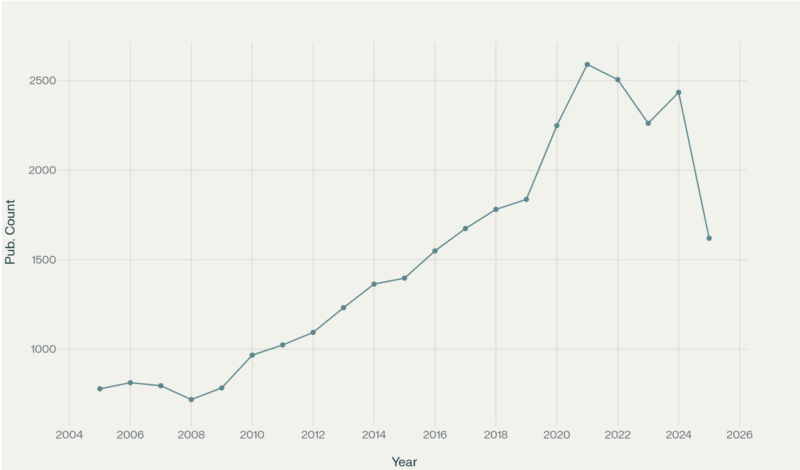 Figure 2
Figure 2
To track publication trends for colorectal cancer, the following keywords were used: “colorectal cancer”, “colon cancer”, “rectal cancer”, “colorectal carcinoma”, and “colon adenocarcinoma”. These terms were connected using the OR operator to ensure a broad search. The annual number of publications retrieved from PubMed between 2005 and 2025 is presented in Figure 3.
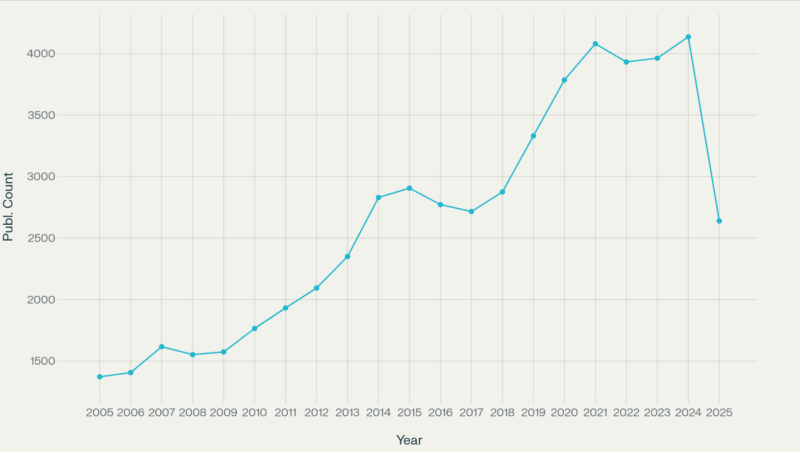 Figure 3
Figure 3
For prostate cancer, the PubMed search included the terms “prostate cancer”, “prostatic carcinoma”, and “prostate neoplasm”. These were combined using the OR operator to capture a wide range of relevant literature. The publication data collected from 2005 to 2025 are displayed in Figure 4, reflecting trends in research volume over time.
 Figure 4
Figure 4
And finally, to assess publication trends for pancreatic cancer, the search terms used were “pancreatic cancer”, “pancreatic adenocarcinoma”, and “pancreatic neoplasm”. These were combined with the OR operator to ensure comprehensive retrieval of relevant studies. The resulting data, covering the years 2005 to 2025, is presented in Figure 5 to illustrate changes in research output over time.
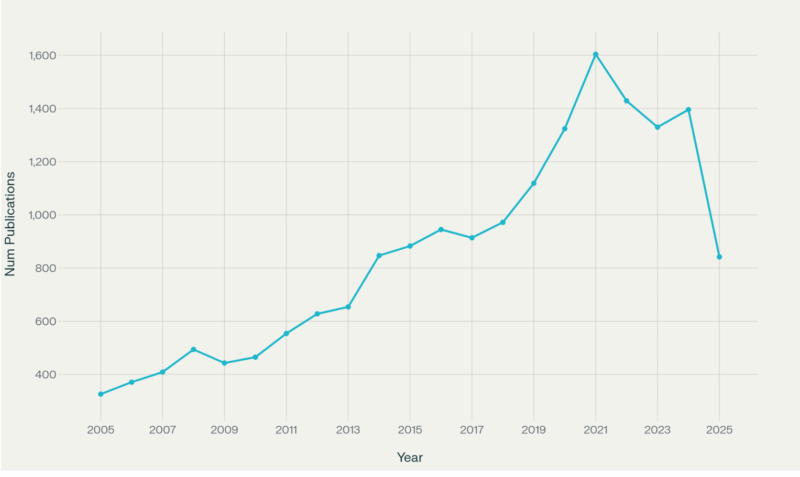 Figure 5
Figure 5
Publication Type Trends in Cancer Research (2005–2025): Growth Patterns in Meta-Analyses, Clinical Trials, and Original Articles
From the perspective of publication type in cancer research between 2005 and 2025, distinct trends emerge in the relative growth and volume of different research formats such as meta-analyses, clinical trials, and original research articles.
Clinical Trials Clinical trial publications have shown substantial growth, especially phase I/II/III trials focused on innovative therapies like immunotherapy, targeted agents, and combination treatments. Since about 2010, there has been a surge in clinical trial reports in cancers such as breast, lung, and pancreatic, reflecting therapeutic breakthroughs. Recent years (2020-2025) continue to see increasing clinical trial publications, driven by precision medicine and novel immunotherapeutic approaches. Meta-analyses have also increased considerably, as accumulated clinical data have allowed for rigorous evidence synthesis in various cancers.
Growth in meta-analyses often lags behind clinical trials by a few years but has become prominent for breast, colorectal, and prostate cancers, helping consolidate treatment guidelines. This publication type notably flourished in the 2010s into the 2020s as systematic reviews became integral for evidence-based oncology practice. Original research articles, especially in molecular biology, genomics, tumor microenvironment, and computational biology, have dramatically increased. These focus areas underpin the development of targeted therapies and biomarkers and have driven the overall rise in cancer publications, especially in breast and pancreatic cancers. The early period (2005-2010) saw basic research dominate the literature growth, with translational studies bridging the gap between lab findings and clinical applications growing thereafter.
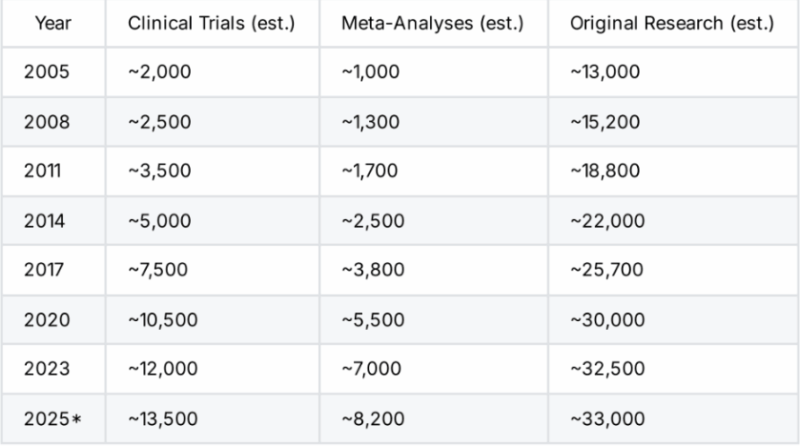
In summary, clinical trials and meta-analyses have risen markedly from 2005 to 2025, reflecting the maturation of cancer therapeutics and evidence synthesis. The growth in meta-analyses tends to follow clinical trial expansions, providing a critical evaluation of cumulative data. Meanwhile, basic and translational research articles have sustained continuous growth, fueling novel therapy development. The trends also vary somewhat by cancer type, with clinical trials being particularly dense in breast, lung, and pancreatic cancers, while meta-analyses grow strongly for colorectal and prostate cancers.
Based on bibliometric data and PubMed trends between 2005 and 2025. Here is an approximate year-wise breakdown of cancer research publications by type—clinical trials, meta-analyses, and original research articles—focusing on the top cancers (breast, pancreatic, lung, colorectal, prostate):
These approximate counts aggregate the top five cancers jointly for illustrative purposes. Individual cancer types show similar trends, with some variation—e.g., pancreatic cancer clinical trial publications increased steeply in recent years due to urgent unmet needs [9, 10].
The five cancer types showing the most explosive growth in scientific publications from 2005 to 2025 have surged due to several converging reasons. The explosive growth in scientific output for these five cancers reflects multifactorial drivers combining rapid therapeutic innovation, advanced molecular techniques, urgent clinical challenges, epidemiological trends, and targeted funding priorities. This dynamic research expansion shapes both scientific progress and public health strategies in oncology.
Advances in immunotherapy, especially immune checkpoint inhibitors and antibody-drug conjugates ADCs, have revolutionized treatment for cancers like breast, lung, and pancreatic cancer. These breakthroughs drive strong research enthusiasm and publication surges, as new therapies generate novel scientific questions and lead to new clinical trials [11]. Increasing incidence rates in some cancers, such as early-onset colorectal cancer, boost research activity. Public health priorities also influence funding and research outputs, as seen with breast and lung cancers, maintaining high prevalence and mortality worldwide.
Global Disparities in Cancer Research: Diverging Priorities and Capacities Between HICs and LMICs
Publication growth and research priorities in cancer vary significantly between high-income countries (HICs) and low- and middle-income countries (LMICs), driven by multiple interrelated factors. High-income countries, particularly the United States, China, and European nations, dominate global cancer research outputs, contributing the majority of publications, highly cited articles, and international collaborations. In specialized fields like glioma exosome research, China leads in publication volume, while Sweden, despite producing fewer papers, demonstrates higher citation averages, highlighting differences in research impact. In contrast, LMICs generally produce fewer publications due to limited funding, infrastructure, and research capacity, though rising cancer burdens in these regions are spurring gradual growth in research activity.
Research focus is closely tied to the local disease burden. In HICs, priorities often reflect prevalent cancers—such as breast, lung, colorectal, and pancreatic—and benefit from robust funding aimed at advancing therapeutic innovations. LMICs, however, encounter distinct epidemiologic challenges, including a higher prevalence of infection-related cancers like cervical and liver cancer, along with a growing incidence of non-communicable cancers. Consequently, research in these settings often centers on prevention, early diagnosis, and cost-effective interventions tailored to local health system capacities [12].
Disparities in research funding further widen the gap. HICs benefit from significantly greater investments, enabling a broad spectrum of research activities, from basic science to precision medicine and immunotherapy trials. LMICs, on the other hand, contend with constrained budgets, underdeveloped infrastructure, and a heavy reliance on international collaborations or aid, which limits the scope and depth of their research efforts.
Access to advanced technology also plays a critical role. HICs are better equipped with diagnostic tools, therapeutic platforms, and clinical trial infrastructure, which accelerates innovation and research productivity. Conversely, LMICs often lack such access, prompting a greater emphasis on epidemiological studies and implementation science to address their unique public health challenges.
Finally, the sociopolitical and academic context influences research capacity and dissemination. Stable governance, strong educational institutions, and research-friendly environments in HICs support vibrant scientific inquiry and international cooperation. LMICs may struggle with political instability, weaker regulatory systems, and language barriers, all of which can hinder both the quality and global visibility of their research.
Global cancer research publication trends reflect these disparities, with HICs driving most advances and publications, while LMICs are emerging contributors focusing on their specific cancer burdens. Bridging this gap requires capacity building, equitable funding, infrastructure development, and fostering international collaborations that respect local contexts and cultures. This contextual understanding is crucial for aligning research efforts with global cancer control objectives, ensuring that scientific progress benefits diverse populations worldwide.
Targeting the Untargetable: Future of Research Trends in Oncology
In 2025, some of the most significant advances in oncology are centered on overcoming the long-standing challenge of targeting so-called “undruggable” cancer molecules—proteins that have previously been resistant to conventional therapeutic approaches. A notable breakthrough has been the successful targeting of the KRAS oncogene family, which was previously considered elusive due to its smooth protein surface and lack of accessible binding pockets.
Building on the FDA approval of Sotorasib (a KRAS G12C inhibitor), next-generation inhibitors such as Divarasib and Adagrasib are demonstrating promising efficacy in clinical trials. These compounds not only extend therapeutic potential to other KRAS variants, including G12D and G12V, but also aim to inhibit pan-RAS activity across multiple tumor types, such as pancreatic and colorectal cancers, representing a major expansion in precision oncology.

Photo: Depositphotos
In parallel, the field is making strides in targeting G protein-coupled receptors (GPCRs), a vast and historically underutilized receptor family. More than half of GPCRs, which play essential roles in cell signaling, are now being explored with novel early-stage drug candidates. These efforts are reinvigorating interest in leveraging GPCR modulation for solid tumor therapies, particularly as new structural insights and screening tools become available.
Another disruptive innovation lies in targeted protein degradation. Compounds known as molecular glues work by inducing proximity between a target protein and the cellular degradation machinery, effectively eliminating proteins once considered intractable. Though still in early clinical phases, molecular glues are enabling access to targets that lack druggable pockets altogether. Similarly, PROTACs (Proteolysis Targeting Chimeras) are advancing in their ability to degrade oncogenic proteins, such as HuR (ELAVL1)—an RNA-binding protein implicated in aggressive breast cancer and other malignancies. Both molecular glues and PROTACs harness endogenous cellular pathways to remove disease-driving proteins with high selectivity and potency, even at low doses, representing a paradigm shift in therapeutic design.
Complementing these developments, fragment-based drug discovery and structure-guided design have opened new avenues for finding functional binding sites on previously inaccessible targets. For example, recent progress in targeting eIF4E, a protein central to oncogenic translation control, offers a blueprint for expanding the chemical space of druggable proteins.
Furthermore, the range of mechanisms used to tackle these difficult targets has diversified significantly. Covalent inhibitors, allosteric modulators, disruptors of protein-protein interactions, and nucleic acid-based therapies are now part of the modern therapeutic toolkit. In combination with next-generation immunotherapies, these modalities are broadening the scope of what is considered “actionable” in cancer drug development.
In sum, 2025 marks a critical turning point in the pursuit of previously undruggable cancer targets. With KRAS, GPCRs, HuR, and eIF4E among those gaining traction, and with innovative platforms including molecular glues, PROTACs, and fragment-based screening leading the charge, the oncology field is witnessing a profound shift, unlocking a new era of precision medicine that redefines therapeutic boundaries.
Conclusion
Cancer research is growing rapidly due to new treatments, technology, and urgent medical needs. In the past, the number of research papers reflected how common and deadly different cancers were, with breast, lung, colorectal, prostate, and pancreatic cancers receiving the most study. This is because these cancers affect many people and have emerging treatment options like immunotherapy and targeted drugs.
However, some highly deadly cancers still do not receive enough research attention. Looking ahead, cancer research is expected to expand by focusing on new ways to target difficult mutations — especially in KRAS-driven cancers — alongside advances in immunotherapy, cancer vaccines, and the use of artificial intelligence to improve personalized treatments.
These new developments, combined with a greater emphasis on previously overlooked cancers and more diverse patient populations, are likely to shift research priorities and improve cancer care. It will be essential to continue monitoring research and funding trends to ensure that resources are fairly distributed, science remains strong, and public health benefits the most.
You Can Also Read Clinical Trials in Cancer Care: What They Are, How to Join, and What to Expect by OncoDaily

You Can Also Read 10 Ongoing Clinical Trials on Immunotherapy in Melanoma by OncoDaily
References
1.Yao, Zhichao, et al. “Global Research Trends on Immunotherapy in Cancer: A Bibliometric Analysis.” Human Vaccines & Immunotherapeutics, vol. 19, no. 2, June 2023, doi:10.1080/21645515.2023.2219191.
2.Rush, Shannon, et al. “Updated Funding to Lethality Measures for National Cancer Institute Funding Allocation (2007-2017).” Gynecologic Oncology, vol. 162, Aug. 2021, pp. S322–23, doi:10.1016/s0090-8258(21)01262-2
3.Kamath, Suneel, MD. “Cancer Funding Disparities and the Impact on Care.” Targeted Oncology, 1 June 2025,
4.Kamath, Suneel D., and Yanwen Chen. “Disparities in National Cancer Institute and Nonprofit Organization Funding Disproportionately Affect Cancers With Higher Incidence Among Black Patients and Higher Mortality Rates.” JCO Oncology Practice, vol. 20, no. 3, Jan. 2024, pp. 378–85, doi:10.1200/op.23.00126.
5.Matthius, Andrew. “Experts Forecast Cancer Research and Treatment Advances in 2025 | Blog | AACR.” American Association for Cancer Research (AACR), 31 Jan. 2025,
6.Susan. “Highlights From the 2025 AACR Annual Meeting.” Let’s Win Pancreatic Cancer, 9 May 2025, letswinpc.org/research/research-highlights-2025-aacr-meeting.
7.Wang, Ruiyu, et al. “Bibliometric Analysis of the Application of Deep Learning in Cancer From 2015 to 2023.” Cancer Imaging, vol. 24, no. 1, July 2024, doi:10.1186/s40644-024-00737-0.
8.Xu, Jie, et al. “Statistics and Pitfalls of Trend Analysis in Cancer Research: A Review Focused on Statistical Packages.” Journal of Cancer, vol. 11, no. 10, Jan. 2020, pp. 2957–61, doi:10.7150/jca.. 43521.
9.Constantio Carlos Reyes-Aldasoro “The Proportion of Cancer-related Entries in PubMed Has Increased Considerably; Is Cancer Truly ‘The Emperor of All Maladies’?” PLoS ONE, vol. 12, no. 3, Mar. 2017, p. e0173671, doi:10.1371/journal.pone.0173671.
10.Chen, Yuxin, et al. “Bibliometric Analysis of Research Trends on the Combination of Radiotherapy and PARP Inhibitors in Solid Tumors.” Frontiers in Pharmacology, vol. 16, May 2025, doi:10.3389/fphar.2025.1603573.
11.“Cancer Facts and Statistics.” American Cancer Society
12.Pramesh, C. S., et al. “Priorities for Cancer Research in Low- and Middle-income Countries: A Global Perspective.” Nature Medicine, vol. 28, no. 4, Apr. 2022, pp. 649–57, doi:10.1038/s41591-022-01738-x.
13.“Priorities for Cancer Research in Low- and Middle-income Countries: A Global Perspective.” Nature Medicine, vol. 28, no. 4, Apr. 2022, pp. 649–57, doi:10.1038/s41591-022-01738-x.
Written by Emma Hovsepyan
FAQ
How are circulating tumor DNA (ctDNA) and liquid biopsies transforming clinical trials?
ctDNA is becoming mainstream for trial patient stratification, minimal residual disease detection, and treatment response monitoring, enabling more precise and minimally invasive cancer management.
What is the current role of artificial intelligence (AI) in oncology research?
AI is embedded across cancer clinical trials and treatment, improving diagnostics, trial matching, biomarker discovery, outcome prediction, and digital pathology accuracy.
What novel therapeutic modalities are gaining traction in cancer treatment?
Advanced biologics such as antibody-drug conjugates (ADCs), bispecific antibodies, and targeted agents for previously undruggable mutations (like KRAS variants) are advancing rapidly.
How are lifestyle factors influencing cancer research focus?
Research increasingly considers obesity, metabolic health, and lifestyle interventions such as structured exercise to reduce recurrence and improve outcomes.
What progress is being made on targeting undruggable cancer mutations such as KRAS?
Second-generation KRAS inhibitors targeting G12D, G12V, and pan-KRAS mutations are in development, showing promise for hard-to-treat cancers like pancreatic cancer.
How is precision medicine evolving in oncology?
A combination of genetic profiling, AI, spatial transcriptomics, and single-cell sequencing enables better targeted therapies and immunotherapy by deepening the understanding of the tumor microenvironment.
What challenges exist with the cost and access of new cancer therapies?
The increasing use of combination therapies pressures healthcare budgets, prompting the need for companion diagnostics and biomarker-driven patient selection to improve cost-effectiveness.
How are clinical trials becoming more inclusive and adaptive?
Trials now emphasize real-time biomarker monitoring, patient-centric design, use of AI for trial matching, and global adaptive protocols to accelerate drug development and accessibility.
What role do radiopharmaceuticals and immune cell engagers play in future cancer care?
Emerging modalities, such as radiopharmaceuticals and conditional immune cell engagers, are expected to improve survival and quality of life by targeting cancer cells more selectively.
What trends are influencing oncology R&D priorities?
Focus areas include early detection technologies, the integration of AI, biomarker-driven therapies, addressing rare cancers, and patient quality-of-life measures.
